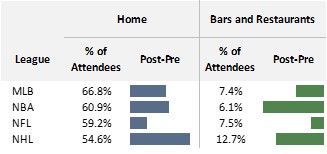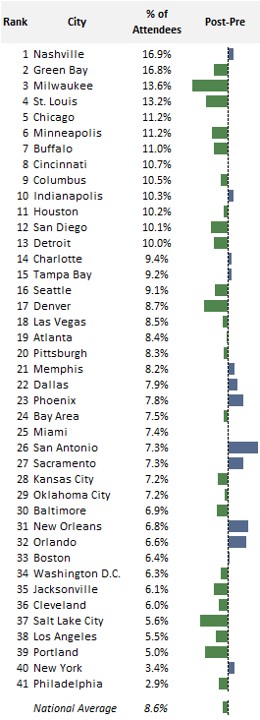Philadelphia fans have an earned reputation for climbing light poles in celebration of major victories, other fanbases throw octopi on the playing surface, and still others jump through tables before the game is even played. Different fanbases behave differently. A statement that is acknowledged as anecdotally accurate but rarely discussed or fleshed out in a quantitative way. Using data from Placer.ai, HVS gathered data on fan behavior before and after games for every NBA, NFL, MLB, and NHL team and aggregated them by location to enable comparison. Los Angeles fans come from or go to their homes before and after games the most of any city, and use bars and restaurants the least. Nashville and Green Bay fans come from home before games or go home after games the least, and they are the most likely to be at a bar and restaurant before or after a game. The differences may be due to the location of stadiums and arenas and their proximity to entertainment centers, they may be due to the culture of a city, and they may be due to the different sports played in each city.
Harrison Butker’s kick in the final seconds in Glendale, Arizona to clinch the Super Bowl LVII for Kansas City, ended the hopes and dreams for the Philadelphia Eagles and their fans. The sad and sullen Eagles fans were a sharp contrast from the NFC Championship game, which ended with the Eagles rushing the field to celebrate their victory, and their fans streaming out of Lincoln Financial Field in jubilation, eager to summit the greased light poles and flood the streets of Philadelphia in triumph. This was a severe case of fan excitement and energy, that would have only intensified had the Eagles prevailed in Glendale. Instead, Kansas City fans shot off fireworks, chanted, and cheered in the streets, but the Kansas City light poles remained alone, deserted, and unconquered.
.jpg)
HVS aggregated the data by regional location or city. For example, Gillette Stadium in Foxboro, MA, the home of the New England Patriots, is grouped with the Boston Celtics, Red Sox, and Bruins and the Prudential Center in Newark, New Jersey, where the Devils play, is grouped with the Yankees, Mets, Nets, Giants, Islanders, and Jets[1]. This enables comparisons to be made across cities and fanbases. HVS focused on two locations attendees of an event came from, or went to, before and after a game: home and a bar or restaurant.
The figure below shows the combined percentage of attendees that come from or go to their homes for all 41 cities studied. It also shows the percentage of attendees who come from home, subtracted from the percentage of attendees who go home after games. This indicates whether fans prefer being home before a game, in the cities with a green bar, or going home after a game more, shown in blue.
Percentage of Game Attendees that Come From or Go To Home

Source: Placer.ai, HVS
Los Angeles fans come from home before a game or go home after a game (78%) more than fans in any other city. Philadelphia fans (76%) may be fanatical, but they are homebodies compared to Nashville fans (37%). As a national average, 61% of fans come from or go to their homes before and after games. This leaves a large share of fans who through their pre- and post-game spending, have a significant impact on the local economy.
Every fan base but Phoenix and Orlando go home after games more than they come from home before games; however, the difference is small (5% more come from a home in Phoenix, and 2% in Orlando) relative to other fanbases. Salt Lake City fans love doing things pre-game, as only 47% of them come from home, but hate making plans post-game, 86% of them head home after a game. Portland and Memphis fans also prefer pregame activities to postgame, with 36% and 35% gaps respectively.
These differences between pre- and post-game may be due to the proximity of major tourist destinations and entertainment districts to venues, like Beale Street in Memphis and the Rose Quarter in Portland, or cultural differences where Salt Lake City nightlife is very limited and there are few alternatives to heading home after game's end. It also may be due to scheduling, where the majority of games in cities without football teams, like Salt Lake City, Portland, and Memphis, occur on weeknights when fans have to be home for work in the morning. The table below summarizes the location of fans before and after games by league.

Source: Placer.ai, HVS
The following figure provides the same city rankings but with bars and restaurants. The difference between pre and post indicates whether fans prefer going to bars and restaurants before a game more, in green, or after a game more, in blue.

Source: Placer.ai, HVS
Nashville and Green Bay fans are the most common users of bars and restaurants before or after a game, with 16.9% and 16.8% of fans respectively. Green Bay and Nashville stand out as the only two fanbases with over 15%, compared to a national average of 8.6% of fans. The fans that use bars and restaurants before and after games the least are Philadelphia and New York, the only fans under 5% in the set.
In most cities, more fans go to bars and restaurants before a game than they do afterward, with the national average before a game being 1.3 percentage points lower after a game than before. The largest gap among the set is in Milwaukee, where 19.2% of fans come from a bar or restaurant but only 8.5% go to a bar or restaurant after a game. In the other direction, only 1.6% of San Antonio fans come from a bar or restaurant before a game while 10.7% go to a bar or restaurant after the game.
The impact of the Midwestern drinking culture is clear at the top of this list and contributes to the almost 1 in 5 Milwaukee attendees being in a bar and restaurant before a game. The decrease after games may be due to scheduling, as was previously mentioned, where most of the basketball and baseball games are on weeknights. The gap in San Antonio where nobody goes out before a game but 10% do after a game, may be due to the location of the arena, more than 3 miles from downtown and far from most bars and restaurants in San Antonio.
There are clear differences in how fans behave before and after pro sports events, past the more unique climbing lamp posts in celebration and throwing dead octopi on the ice rink. Los Angeles fans are the biggest homebodies, closely followed by Philadelphia, who are both rarely found in a bar or restaurant before or after a game. These fanbases are contrasted by the lively folks in Nashville and Green Bay, who come from or go to bars and restaurants the most and home the least. This could be due to the location of the arena in each city, relative to the entertainment hubs, or the cultural values of the fans, like in Salt Lake City. It may also be due to the different sports leagues that compete in each city: NHL fans come from and go to home the least and use bars and restaurants the most, while baseball fans come from or go to home the most and NBA fans use bars and restaurants the least.
[1]The Knicks and Madison Square Garden were excluded from the analysis because of Madison Square Garden’s location above Penn Station, which skews the data.